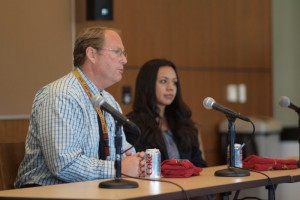Panel discusses sustainability on campus
Green groups at USC discussed various initiatives on campus that aim to address issues such as waste, green buildings, water and energy, at a panel Tuesday.
USC’s sustainability rating was recently raised from a C+ to a B- by the Sustainability Endowments Institute, but many campus groups are still working to make the university greener.

Green · Eric Johnson, director of Facilities Management Services, and Daniela Arellano, green office liason for the Office of Sustainability, spoke about different ways to recycle and how to make buildings more energy efficient. - Sunil Murali | Daily Trojan
Four of these groups — Net Impact, CalPIRG, the Office of Sustainability and Facilities Management Services — talked about some of their goals and projects Tuesday as part of the Campus Conversation Series.
Net Impact, a student group that lobbies for corporate responsibility and sustainability on campus, introduced a pilot program this semester that will have classrooms use reusable dry erase markers instead of Expos in classrooms.
“We will be implementing the program through Marshall School of Business next fall,” said Catherine Uong, a freshman majoring in business administration and secretary of Net Impact. “You will see the markers in classrooms then.”
This semester, CalPIRG, a political public interest group that has chapters at various schools, has worked on a plastic bag ban that has been adopted by unincorporated areas in Los Angeles, though not the city as a whole. The group is also working on clean car initiatives.
“One of our core campaigning efforts this year was our clean car initiatives … We’ve been campaigning to put one million more energy efficient cars on the road by 2025,” said David Mittelstein, the head of CalPIRG.
CalPIRG and Net Impact both have plans to raise awareness during Earth Week, which is next week. CalPIRG plans to show Chevrolet’s Volt as an exhibit and to talk about green technology. Net Impact plans to host a waste program at The Row, as well as a panel and a fashion show.
The Office of Sustainability and FMS have also made major accomplishments this year, but both hope to be able to do more.
“Our mission is to institutionalize sustainability by making sustainability part of the everyday work of the school by making it second nature,” said Daniela Arellano, a green office liason of the Office of Sustainability.
Arellano said the Office of Sustainability has worked with office leaders in various buildings to teach them how to make the buildings more energy efficient. Many buildings, such as the Ronald Tutor Campus Center, have earned LEED — Leader in Environmental and Energy Design certification, meaning they use water and energy efficiently.
Arellano also hopes USC can further decrease its emission of greenhouse gases.
There is currently a server in place that collects information to determine how much energy a building uses in a single day. Arellano said she hopes the information is used by students for research, and possibly as a part of competition to see which building can cut down its energy use the most.
FMS has also been working to help the environment by putting less waste in landfills.
Last year USC generated more than 7,800 tons of trash. Eric Johnson, director of FMS, said 51 percent was diverted from landfills by using a Material Recovery Facility to search for recyclable goods.
FMS has also bought a densifier that melts styrofoam to condense it and make it recyclable and has been working on landscaping.
“When we talk about landscapse there’s a lot of things we can do to be sustainable,” Johnson said. “In the last few years, whenever we did a project we incorporated green landscaping.”
In landscaping projects, organic mulch is used, which releases nitrogen for plants to use and helps them with nutrients. The group is also using dripline irrigation, a low flow irrigation system that directs more water to the plant with little running onto the sidewalk.
FMS is also using natural pruning and evapotranspiration to measure how much water is in the air.
FMS built a 3-million-gallon thermal energy tank under the track field in 2004. During off-peak hours when electricity is cheaper, the water is cooled down. When electricity is more expensive, the tank is used to provide electricity. Johnson said the project was expensive, but is paying for itself.

What about USC’s $3.7 billion endowment? Is there any attempt to try to invest billions of dollars in companies that aren’t devastating the environment? Probably not, as USC’s endowment is completely private information and that, generally, less environmentally friendly companies are more often more profitable.
how about spending more resources on providing more recycling bins and educating USC students on how/why to recycle instead of relying on a Material Recovery Facility to pull out recyclables…that way we’re encouraging long term environmental consciousness???